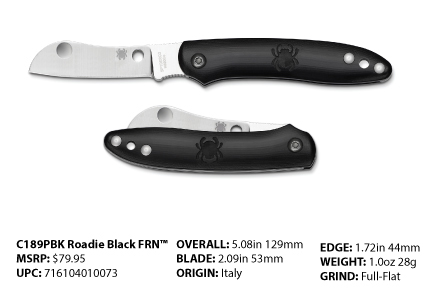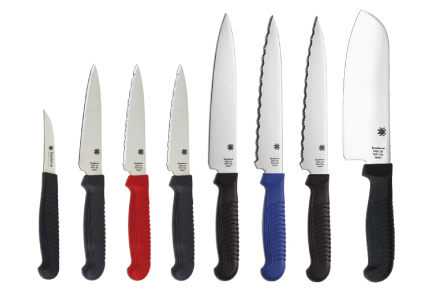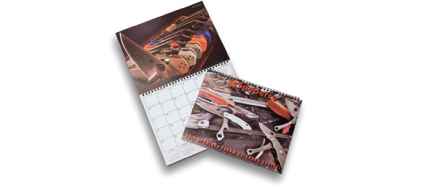
|
|

|

Following the tragic events of September 11, 2001, the carry of any type of knife aboard an airplane was strictly prohibited. In early 2013, the Transportation Security Administration (TSA) announced a plan to change U.S. security regulations and once again allow knives on airplanes. Although the plan was later withdrawn, Spyderco had already risen to the occasion by designing a highly functional non-locking pocketknife that would have conformed with the TSA’s proposed guidelines. That knife is the Roadie. In essence, the Roadie is a highly evolved penknife that is more practical and user friendly than its historical predecessors. It’s most distinguishing characteristic—the “Double Dent™—is a pair of symmetrical dimples in the blade that provide a solid purchase for a fingernail-free two-handed opening. Far superior to a traditional nail nick, they also do not collect dirt or debris. Unlike traditional penknives, the Roadie also features a subtle index-finger choil that increases control of the knife during use and acts as a safeguard against unintentional closure. These enhanced features elevate the Roadie far beyond the conventional penknife and set a new standard in socially friendly cutting tools. Although the knife was never given the opportunity to respond to its original “calling,” the result of the project was far too good to pass up. The business end of the Roadie is a sheepfoot-style blade ground from Böhler-Uddeholm N690Co steel, a high-performance stainless steel alloyed with cobalt, molybdenum, and vanadium. Its wide blade profile and full-flat grind create incredible edge geometry for a keen, scalpel-sharp edge. The broad blade also provides real estate for the distinctive “Double Dent” feature that allows the blade to be easily opened with a pinch grip of the thumb and index finger. Although not intended as an opening feature, a Trademark Round Hole™ in the blade proudly identifies the Roadie as a Spyderco product. At the base of the blade near its juncture with the handle there is a subtle forefinger choil (finger groove). Placing your index finger on the choil provides excellent control of the edge and creates a natural “stop” to help prevent the knife from closing unintentionally. Both the choil and the opposing thumb ramp on the spine of the blade feature jimping (textured grooves) to promote a positive, non-slip grip. Unlike a traditional slipjoint, the Roadie’s blade is held open by an improved notched-joint mechanism. Its spring also forms the handle’s full-length back strap, giving it structural strength and providing a foundation for the durable fiberglass-reinforced-nylon (FRN) scales. The injection-molded scales are contoured for comfort and feature a proud Spyderco “bug” logo on both sides. They are also available in a wide variety of colors to suit every taste. The Roadie represents a quantum leap in the evolution of modern pocketknife design and sets a new standard of excellence for the breed. We are confident that yours will serve you well. |

|
|

|
MAKING HISTORY AGAIN... SPYDERCO KITCHEN KNIVES ARE BACK! Spyderco’s involvement in kitchen knives dates back to the early 1980’s and the beginnings of our company’s knife production. While fostering manufacturing relationships in Japan for our revolutionary folding knives, we were offered the chance to produce a series of kitchen knives with a highly regarded Japanese company. We embraced that unique opportunity and ultimately introduced a full line of kitchen cutlery, including everything from mini paring knives through full-sized chef’s knives. In the process, we also became the first company to introduce a commercial Santoku (a distinctive Japanese knife similar to a cleaver) to the U.S. market. Spyderco’s original kitchen knives were ground from MBS-26, a proprietary stainless steel available exclusively to one Japanese manufacturer. Ground exceptionally thin and painstakingly heat treated, these knives actually outperformed the chemistry of the steel and quickly gained a devoted customer following. Thee serrated versions also featured a highly evolved tooth pattern that was scientifically designed to remain sharp despite repeated contact with a cutting board. All knives in the original series featured injection-molded handles made from Sermollan—a lightweight, rubberized plastic with a semi-soft texture that provided a secure grip, even when wet. To evaluate the long-term performance of its kitchen knives, Spyderco’s founder Sal Glesser personally provided samples to restaurants and food vendors around the world. During his travels to international trade shows, Glesser would check on the status of these knives, sharpen them as needed, and collect feedback from the professionals that used them. Over the years, this invaluable information served as the basis for minor changes and improvements that brought these workhorse designs even closer to perfection. After many years of production, Spyderco was forced to discontinue its kitchen knives around 2005 due to changes in the relationship between its Japanese trading company and the factory producing the knives. Although we explored a number of alternative approaches to manufacturing high-quality kitchen cutlery, none equaled the performance or the passionately devoted following of our original kitchen series. Fortunately, after careful negotiations and strict adherence to the traditions of Japanese business culture, Spyderco was able to “rekindle an old marriage” with our original manufacturer and in 2014 began reintroducing improved versions of select kitchen models. As we move into 2015, Spyderco is proud to bring back additional kitchen knife models to recreate the breadth and variety of our original line. Within the next few months, we will be shipping paring knives, mini paring knives, utility knives, and the Santoku. Other blade shapes and designs may also be added in the future. Like their predecessors, these knives all boast premium MBS-26 stainless steel blades. MBS-26 contains 0.85-1.00% Carbon, 13-15% Chromium, and trace amounts of Manganese, Molybdenum, Phosphorus, Silicon, and Sulphur; however, thanks to the extreme attention to detail exercised during its heat-treatment process, its performance far exceeds the expectations its alloy composition would suggest. To further optimize the performance of this steel, Spyderco kitchen knives are ground exceptionally thin for superior edge geometry and some designs also offer the option of either a PlainEdge™ or fully serrated SpyderEdge™ blade. Spyderco’s current kitchen knives also feature a major improvement over the originals. Rather than Sermollan, their handles are injection molded from polypropylene plastic for even greater durability. The handles are all molded directly onto the blade tangs and feature a distinctive “stepped” texture pattern that provides exceptional comfort and control during use. Depending upon the model, they are also available in several different color choices. Spyderco’s kitchen knives represent an important part of our history as a manufacturer and we are very proud to once again feature them in our product line. We welcome your comments and feedback on their performance, as well as your suggestions for other patterns of kitchen knives you’d like to see us make. 
|

|
|

|
SPYDERCO 2015 FORUM CALENDAR Spyderco maintains a discussion forum at http://www.spyderco.com/forumII/. Here resides a community of Spyderco-minded people who congregate 365 days a year in ongoing conversations about Spyderco products. They share knife and sharpening information and experiences, as well as their knowledge about everything that is Spyderco. It’s a friendly family of knife knuts, many of whom participate in our annual Forum Calendar Contest. Forumites submit original artwork and photos featuring their favorite Spyderco Knives. The winning artwork submissions are made into a 12-month wall calendar. As a Spyderco dealer or distributor, you should be receiving one along with your new 2015 Spyderco Catalog. If you have not, contact your Spyderco sales representative today. 
|

|
|

|
WE WANT TO HEAR FROM YOU: CUSTOMER EXPERIENCE LETTER Dear Spyderco, In September I purchased a Spyderco Tenacious Folder. It has been my everyday carry since. Last week your knife helped me save my neighbor’s dog. My dog and my neighbor’s dog are both very large best friends. They play and wrestle together in our shared backyard daily. I was in the house reading and heard yelping and found my neighbor’s dog had a mesh collar on that had become wrapped around my dog’s lower jaw. Both dogs are 75 pounds and were flailing and choking to free themselves. I tried removing the collar and was bitten in my attempts by the panicking dogs. My neighbor’s dog suddenly went limp and his tongue was blue. He had stopped breathing. At this point I knew I had to risk bringing the blade into the fray and was able to rapidly and single-handedly access the knife and with a quick motion the cut the collar off. The dog revived and I am happy to report that neither dog sustained serious injury. Both are back to their happy numb-skull selves and both my neighbor and I both are fortunate to have our faithful companions. This is why I want to thank you for providing me with the tool I needed to save the day. My three children still have their beloved pet! With Gratitude, Gregg (and the dogs Gus and Joe) 
|

|
   
|
   
|

|